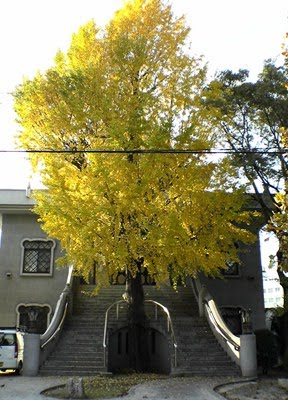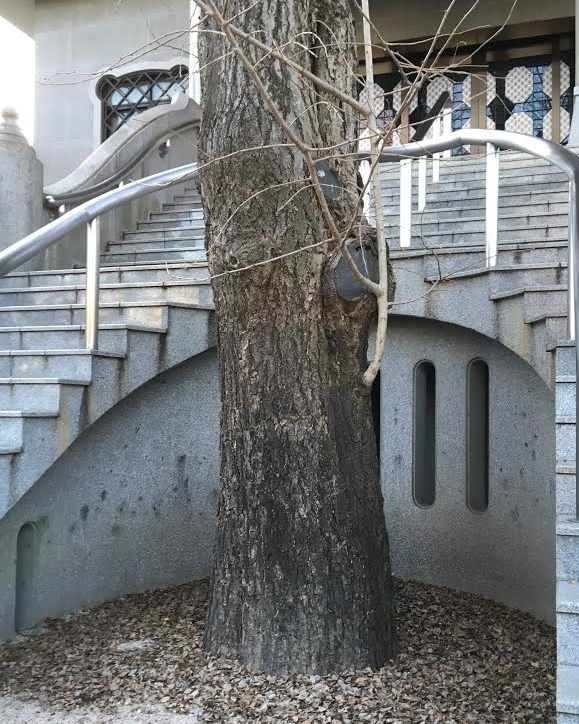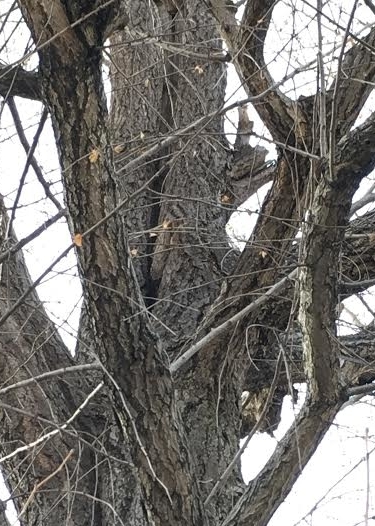The third installment of my translations from Yūko Ishida’s Meeting Hiroshima’s Trees is about the ginkgo located in front of Hōsenbō’s main hall.
* * *
The Scarred Ginkgo: Hibakujumoku Tilt?
We visited a temple called Hōsenbō in Hiroshima’s Teramachi neighborhood that was 1.13 kilometers from the hypocenter. As the name Teramachi (literally “temple town”) would suggest, there are many temples in this area, including one nearby that houses a hibakujumoku crepe-myrtle and Japanese sago palm.

If one stands in front of Hōsenbō, an atomic-bombed ginkgo, thought to be 150 years old, rises tall in front of the temple’s main hall. When viewed as a whole, the building’s shape and the ginkgo give a unique impression. The stairs leading up to the main hall circle the ginkgo in a U.
“This tree has a scar remaining from the atomic bomb. The upper part of the trunk has a fissure on the side facing the blast’s hypocenter. If you look closely, bark on that side of the tree is different from the rest. Other parts are robust and plump, but bark on the side exposed to the blast is more close-textured. Because of that, this tree tilts slightly toward the hypocenter. The trunk is growing straight, so it’s quite easy to see the tilt. Fifty years after the war, when it was decided that the main hall would be rebuilt, those connected with the temple met to discuss what was to be done about the tree, which was so close to the building; they decided on this shape for the stairs.”
“You advised them during that process?”
“Yes. The roots used to be surrounded by plates of iron grating, but that might have damaged the roots and trunk as the tree got bigger, so I’ve been removing them. If possible, the fallen leaves shouldn’t be thrown out; they should be allowed to accumulate around the tree and turn into fertilizer. When the stairs were built, holes were put in the wall surrounding the tree to allow wind to pass through and improve ventilation.

“People who walk near here probably notice the building’s shape and can see that the tree is being treated with great care. They may ask the temple, ‘Why is that?’ Then the people here will be able to tell them, ‘This ginkgo endured the atomic bomb and survived.’ That’s why I’m glad the tree remains here in this shape. I think this tree, in silence, evokes various things.”
When I too asked if I could talk with the people of the temple, Shōko Togashi, wife of the chief priest, kindly agreed to speak with me.
“I’m told the ginkgo is my dad’s birth tree. My dad was born in Meiji 13 (1910), and it seems the ginkgo was planted in front of the main hall right around that time. In the summer of 1945, even the gardener had gone off to be a soldier, and there was no one to prune the tree; the branches grew as much as they could, and the leaves flourished. When the atomic bomb was dropped, this tree protected the main hall from the heat of the explosion, so the building wasn’t burnt as severely as one would expect. The tree had plenty of leaves, and ginkgo hold lots of moisture too. Although the hall wasn’t burnt, it still collapsed from the blast. My father’s younger brother was crushed by the main hall and died, and so did a cousin who was in the kitchen at the time. Around a month after that, my grandfather and aunt also died from the a-bomb sickness.”
Togashi-san spoke as she showed me photos of her family members who had died.

“After the war, the temple grounds became considerably smaller than before due to town planning efforts to widen the roads. When it was decided to rebuild the main hall, the plan was to cut down the ginkgo to make room for the building. We spoke many times with the congregation about what to do with this tree. Some of them said, ‘We often played by this tree in our childhood,’ or, ‘When people around me died of the atomic bomb sickness, and I also wondered whether I would survive, I saw this tree putting out shoots and thought I could somehow go on living.’ My father also said he wouldn’t want to cut down the tree, no matter what; he had lost his family and the temple’s the main hall, and only this tree remained. Therefore, everyone gave their approval for the current design of the main hall.
“Although I don’t have any personal experience of the bombing, I speak to the children who come here for peace education about how this tree is treasured by the people who know of it.”
At Hōsenbō, the people affected by a single tree gathered many times, shared their feelings about it, and were able to devise a plan for how to let the tree live. Not only was the tree able to be left alive, but I think the conversations surrounding the tree are wonderful as well. If the people of the area share the desire to take care of the tree, it will be able to live a long life in this neighborhood and be respected as a living thing.
* * *
「傷あとをのこすイチョウ」、石田優子の『広島の木に会いにいく』、 70-75ページ
Meeting Hiroshima’s Trees is published by Kaisei-sha (偕成社). Excerpts are posted with the permission of the author. Translations are my own, as an individual.
Links to previous Hibakujumoku Translation posts:


One Reply to “Hibakujumoku Translation: “The Scarred Ginkgo: Hibakujumoku Tilt?””